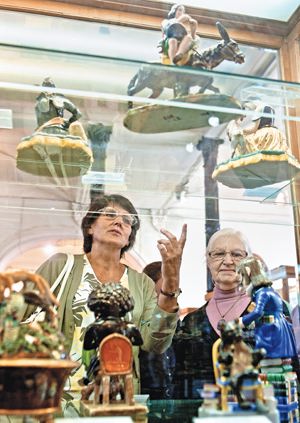Legendary porcelain from Sumy region

Produce of Oleksandr Miklashevsky’s manufactory, one of the leading factories of the 20th century, is on display at Kyiv’s Museum of Ukrainian Folk Decorative Art. The factory was operating in the period between 1839 and 1861 in the village of Volokytyn of Chernihiv gubernia (currently Sumy oblast), hence “Volokytyn porcelain,” the name of the produce known in the whole world. The museum’s exposition consists of only antiquary and unique items. For example, the fragments of the porcelain iconostasis from Volokytyn’s Church of the Holy Protection, ruined in 1956, as well as the porcelain chandelier from the office of Oleksandr Miklashevsky, the owner of the estate who founded the factory.
The porcelain iconostases manufactured at the Volokytyn factory are a unique Orthodox phenomenon; nothing of this kind has ever been present in the Catholic tradition. However, Miklashevsky most likely borrowed the idea of creating monumental architectural structures from the French interior designers, as well as producers of original porcelain goods of the 18th century at the Vienna manufactory, whose manufacture was meant for Versailles and other palace complexes. The collection of the fragments of the iconostasis of the Church of Holy Protection, one of the home estate churches of the Miklashevskys, have been preserved in good condition because they are made of high-quality materials, and the time has no power over them: such porcelain does not become damp or musty, nor does it rot. The multicolored paints, with which the fragments were painted almost 150 years ago, have not darkened. And they have never undergone any restoration. Already at the entrance to the exhibit you plung into the “sea of porcelain.” The amount of what the organizers of the exhibit show is truly impressive. Overall, over 350 items are on display: figured tableware, decorative vases, small statuettes, utilitarian wares, household wares, tea, dessert, and dinner sets. The exposition includes items from Ukrainian museums (Odesa, Kharkiv, Kyiv, and Sumy), as well as private collections.
Porcelain is often called an aristocrat. It is very shrewd and hard to work with. In spite of this, the masterfulness of the works on display is really impressive. Influences of absolutely different styles, like gothic, antique, can be traced in the artistic decoration of the Volokytyn wares, but the “second rococo” is prevailing, which means fanciful shapes, ornaments with scrolls, elements of relief adornment (flowers, fruit, and birds), paintings, and gilding.
The porcelain body is quite unique: it depicts famous historical personalities (like Napoleon), heroes of literary works (executed in the form of grotesque inkpots), medieval knights, musketeers, beautiful ladies, as well as statuettes of peasants. All of them are comic.
Newer works, dated 20th century, are also present at the exhibit. They do not contradict the idea of the exposition, on the contrary they show the development of the porcelain manufacturing in over two centuries.
The exhibit will be open until as late as November 30 at the National Museum of Ukrainian Folk Decorative Art in the Lavra. Incidentally, you can also buy here a new twovolume publication, Porcelain of A. M. Miklashevsky’s Plant, which was launched at the vernissage.
Newspaper output №:
№51, (2011)Section
Time Out





